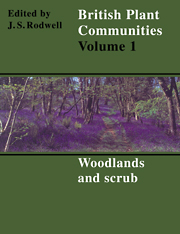Book contents
- Frontmatter
- Contents
- List of Figures
- Foreword
- Preface and Acknowledgements
- Preamble
- General Introduction
- Woodlands and Scrub
- Introduction to Woodlands and Scrub
- Key To Woodlands and Scrub
- Community Descriptions
- W1 Salix Cinerea-Galium Palustre woodland
- W2 Salix Cinerea-Betula Pubescens-Phragmites Australis Woodland
- W3 Salix Pentandra-Carex Rostrata Woodland
- W4 Betula Pubescens-Molinia Caerulea Woodland
- W5 Alnus Glutinosa-Carex Paniculata Woodland
- W6 Alnus Glutinosa-Urtica Jzozca Woodland
- W7 Ainus Glutinosa-Fraxinus Excelsior-Lysimachia Nemorum Woodland
- W8 Fraxinus Excelsior-Acer Campestre-Mercurialis Perennis Woodland
- W9 Fraxinus Excelsior-Sorbus Aucuparia-Mercurialis Perennis Woodland
- W10 Quereus Robur-Pteridium Aquilinum-Rubus Fruticosus Woodland
- W11 Quereus Petraea-Betula Pubescens-Oxalis Acetosella Woodland
- W12 Fagus Sylvatica-Mercurialis Perennis Woodland
- W13 Taxus Baccata Woodland
- W14 Fagus Sylvatica-Rubus Fruticosus Woodland
- W15 Fagus Sylvatica-Deschampsia Flexuosa Woodland
- W16 Quereus spp.-Betula spp.-Deschampsia Flexuosa Woodland
- W17 Quereus Petraea-Betula Pubescens-Dicranum Majus Woodland
- W18 Pinus Sylvestris-Hylocomium Splendens Woodland
- W19 Juniperus Communis Ssp. Communis-Oxalis Acetosella Woodland
- W20 Salix Lapponum-Luzula Sylvatica Scrub
- W21 Crataegus monogyna-Hedera helix scrub
- W22 Prunus Spinosa-Rubus Fruticosus Scrub
- W23 Ulex Europaeus-Rubus Fruticosus Scrub
- W24 Rubus Fruticosus-Holcus Lanatus Underscrub
- W25 Pteridium Aquilinum-Rubus Fruticosus Underscrub
- Index of Synonyms to Woodlands and Scrub
- Index of Species in Woodlands and Scrub
- Bibliography
W24 - Rubus Fruticosus-Holcus Lanatus Underscrub
Published online by Cambridge University Press: 04 July 2020
- Frontmatter
- Contents
- List of Figures
- Foreword
- Preface and Acknowledgements
- Preamble
- General Introduction
- Woodlands and Scrub
- Introduction to Woodlands and Scrub
- Key To Woodlands and Scrub
- Community Descriptions
- W1 Salix Cinerea-Galium Palustre woodland
- W2 Salix Cinerea-Betula Pubescens-Phragmites Australis Woodland
- W3 Salix Pentandra-Carex Rostrata Woodland
- W4 Betula Pubescens-Molinia Caerulea Woodland
- W5 Alnus Glutinosa-Carex Paniculata Woodland
- W6 Alnus Glutinosa-Urtica Jzozca Woodland
- W7 Ainus Glutinosa-Fraxinus Excelsior-Lysimachia Nemorum Woodland
- W8 Fraxinus Excelsior-Acer Campestre-Mercurialis Perennis Woodland
- W9 Fraxinus Excelsior-Sorbus Aucuparia-Mercurialis Perennis Woodland
- W10 Quereus Robur-Pteridium Aquilinum-Rubus Fruticosus Woodland
- W11 Quereus Petraea-Betula Pubescens-Oxalis Acetosella Woodland
- W12 Fagus Sylvatica-Mercurialis Perennis Woodland
- W13 Taxus Baccata Woodland
- W14 Fagus Sylvatica-Rubus Fruticosus Woodland
- W15 Fagus Sylvatica-Deschampsia Flexuosa Woodland
- W16 Quereus spp.-Betula spp.-Deschampsia Flexuosa Woodland
- W17 Quereus Petraea-Betula Pubescens-Dicranum Majus Woodland
- W18 Pinus Sylvestris-Hylocomium Splendens Woodland
- W19 Juniperus Communis Ssp. Communis-Oxalis Acetosella Woodland
- W20 Salix Lapponum-Luzula Sylvatica Scrub
- W21 Crataegus monogyna-Hedera helix scrub
- W22 Prunus Spinosa-Rubus Fruticosus Scrub
- W23 Ulex Europaeus-Rubus Fruticosus Scrub
- W24 Rubus Fruticosus-Holcus Lanatus Underscrub
- W25 Pteridium Aquilinum-Rubus Fruticosus Underscrub
- Index of Synonyms to Woodlands and Scrub
- Index of Species in Woodlands and Scrub
- Bibliography
Summary
Synonymy
Marginal Society Salisbury 1916,1918a p.p.; Marginal flora Tansley 1939 p.p.
Constant species
Rubus fruticosus agg., Holcus lanatus.
Physiognomy
The Rubus fruticosus agg.-Holcus lanatus underscrub is typically dominated by mixtures of brambles, rank grasses and tall dicotyledons, forming an untidy cover of rather variable height, but usually less than 1 m. Although it is very commonly found in close association with taller woody vegetation, in active successions and in stabilised zonations around scrub and woodland margins, trees and shrubs are characteristically sparse within the community itself. There are sometimes scattered Crataegus monogyna, Prunus spinosa, Sambucus nigra and saplings of Fraxinus excelsior, Acerpseudoplatanus, Fagus sylvatica or Quercus robur, but their total cover is generally low.
R. fruticosus agg. is a constant component of the vegetation but its abundance is rather variable. In many stands it is very plentiful, forming dense clumps of tangled arching shoots and, in such cases, most of the other plants are confined to the margins of the bushes or areas between them. In other stands, brambles occur as more widely scattered bushes or as sparse shoots throughout, when the proportion of herbs is consequently greater. Where the community occurs on hedgebanks, where it typically forms a narrow zone between hedge and verge, the bramble cover may be occasionally cut back, but this vegetation is not regularly mown. Other under shrubs are relatively infrequent but Rosa canina agg. or R. arvensis are sometimes found and, on more acid soils, there can be some Ulex europaeus.
A rank growth of grasses is usually a prominent feature of the community. The commonest species throughout are Holcus lanatus and Dactylis glomerata, but Arrhenatherum elatius also occurs quite frequently and, with Festuca rubra, is especially characteristic of one kind of Rubus-Holcus underscrub. Brachypodium sylvaticum is occasionally found on more base-rich soils and, where drainage is impeded, Deschampsia cespitosa can be abundant. Where there is little or no grazing, the usual state of affairs, these species grow as bulky tussocks between or fronting the bramble; where herbivores have gained access after the bramble cover has developed, the grasses may continue to bulk large in the cropped sward extending between the stabilised or regressing bush cover. Smaller grasses, too, can make some contribution to the vegetation.
- Type
- Chapter
- Information
- British Plant Communities , pp. 357 - 363Publisher: Cambridge University PressPrint publication year: 1991



